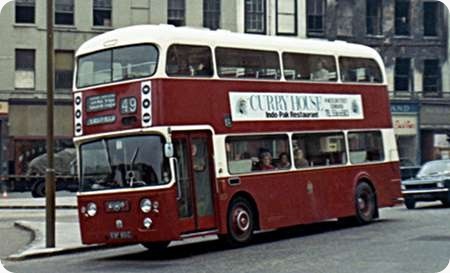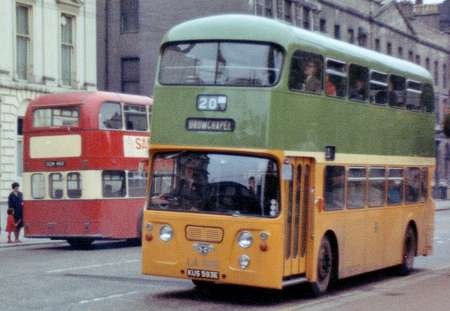Edinburgh Corporation – Leyland Atlantean – ESF 801C – 801
Edinburgh Corporation
1966
Leyland Atlantean PDR1/1
Alexander H43/31F
This photo shows Edinburgh Corporation 801 ESF 801C taken in 1967, 801 was the corporation’s first Atlantean with Alexander H74F bodywork delivered in February 1966,it was I think the first double deck body with panoramic windows and may have been exhibited at the 1965 Scottish motor show at Kelvin Hall which could explain it’s 1966 delivery. The next batch 802-825 EWS 802-825D with identical Alexander bodies were delivered in October 1966 had the then normal short window bays and these were delivered shortly after 826-850 EWS 826-850 which were Leyland PD3A/2’s with Alexander H70F bodies, canny Scots hedging their bets perhaps.
Photograph and Copy contributed by Diesel Dave
19/06/14 – 09:33
Beauty is in the eye, as they say. The big window version of the Alexander ‘Y’ type, was arguably the best looking single deck Bus or D/P of its generation. However, as with the Southdown Queen Mary, for me the big window version of these just didn’t work. The NGT Group had a number of the small window versions, Newcastle Corporation had both large and smaller window types, they also had some rather strange large window types with the stairs on the ’ wrong’ side, and a centre exit. After a series of accidents, the union refused to use the centre exit, and as the vehicles were due for overhaul, the doors were removed and extra seats fitted.
Ronnie Hoye
21/06/14 – 06:29
Centre exits seem to have been a passing fad of the late 1960s. What was the real issue with them, as they seem to be the norm in other countries? I’m aware from reading some of these postings that there were structural problems with some single deck dual door bodies. Or was the main thing that the unions didn’t like them, as Ronnie mentions?
Keith
21/06/14 – 08:55
There were structural problems on double deckers as well. SELNEC had problems in later life with Mancunians. There were problems with accidents and the unions, in the interest of their members, took against them. Meant to reduce time at stops by having all passengers disembark at the centre door, all too often they didn’t and many tried to board there leaving the driver trying to collect fares, deal with any form of pre paid passes and monitor the centre door as well as keeping an eye on the seats remaining, in a difficult position.
Multi doors work well elsewhere where either the bulk of fares are prepaid or there is a second crew member and where some form of load counting actually works – the technology of the time didn’t.
Phil Blinkhorn
21/06/14 – 15:21
Silly question, perhaps, but is it really a LEYLAND Atlantean? I ask because some for Scottish operators had ALBION badges, including Glasgow’s KUS607E which now resides at the St Helens museum.
Pete Davies
22/06/14 – 06:38
Yes this was definitely a Leyland Atlantean Pete as you can see the figure of Atlas on the badge whereas the Glasgow Albion badged Atlantean’s had the St Andrews cross in it’s place as can be seen on the attached photo of KUS 593E taken a couple of years later in central Glasgow.
Diesel Dave
22/06/14 – 09:05
I seem to remember that the Albion badge on the Atlantean was a Glasgow only spec.
Phil Blinkhorn
22/06/14 – 13:04
Thank you, Dave and Phil!
Pete Davies
23/06/14 – 06:33
It could be that it was more efficient to send several chassis in kit form to be assembled at the Albion works in Glasgow, and then onto Alexander to have the body fitted, rather than one at a time in completed form, after all, the Alexander works was at Falkirk, which is not that far from Glasgow. At the end of the day, any differences would probably be down to badge engineering.
Ronnie Hoye
16/08/14 – 05:49
The "Albion" Atlanteans supplied to Glasgow followed a batch of "Albion" PD3s. Leyland got the blame for deleting half the Albion range in the early 1950s after the Albion takeover, when in actual fact Albion were already in the process of doing just that when financial troubles caught up with them. The Albion badges were applied as a gesture to the Glaswegian population in an attempt to settle the ill-feeling.
Paul
17/08/14 – 07:35
Edinburgh and Lothian stuck with dual doors into the low floor era. The Leeds dual door buses gave 15 plus years of service. In later years they found themselves in such esoteric locations as Ilkley and Skipton following the absorption of WYRCC by Yorkshire Rider.
Chris Hough
Quick links to the - Comments Page - Contact Page - Home Page
Comments - Please note: The comments facility is not currently available. Please see the home page for updates.
Please Note if you want to send a photograph with your comment please use the Contact Page by clicking here or send as an attachment via email.


